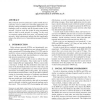ASUNAM
2010
IEEE
14 years 1 months ago
2010
IEEE
The phenomenal success of social networking sites, such as Facebook, Twitter and LinkedIn, has revolutionized the way people communicate. This paradigm has attracted the attention ...
ASUNAM
2010
IEEE
14 years 1 months ago
2010
IEEE
We propose a new approach to visualize social networks. Most common network visualizations rely on graph drawing. While without doubt useful, graphs suffer from limitations like cl...
ASUNAM
2010
IEEE
14 years 1 months ago
2010
IEEE
There is substantial interest in the effect of human mobility patterns on opportunistic communications. Inspired by recent work revisiting some of the early evidence for a L
EUROISI
2008
14 years 1 months ago
2008
This paper presents an application of information theory to identify sets of key players in social networks. First, we define two entropy measures that we use to analyze the struct...
CSCW
2008
ACM
14 years 1 months ago
2008
ACM
Social networks are popular for online communities. This paper evaluates the risk of sophisticated context-aware spam that could result from information sharing on social networks...
CSCW
2008
ACM
14 years 1 months ago
2008
ACM
Within a group of peers, it is often useful or interesting to know whether someone in the group has gone to bed or whether they have awakened in the morning. This information, nat...
CONEXT
2008
ACM
14 years 1 months ago
2008
ACM
Delay-tolerant network architectures exploit mobile devices carried by users to enable new networked applications. Efficiently routing information through these DTNs faces new cha...
COMSWARE
2008
IEEE
14 years 1 months ago
2008
IEEE
Social networks refer to structures made of nodes that represent people or other entities embedded in a social context, and whose edges represent interaction between entities. Typi...
CISSE
2008
Springer
14 years 1 months ago
2008
Springer
-- Networks composed of large number of nodes interacting in structured ways such as power grids, communication networks, social networks or market networks are critical port of th...
CHI
2008
ACM
14 years 1 months ago
2008
ACM
In this paper we describe the development of a platform that enables us to systematically study online social networks alongside their real-world counterparts. Our system, entitle...


